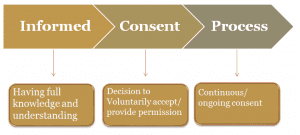Informed Consent Process
Informed consent of research subjects is critical, and is more than just a document & signature – it is an ongoing process. Here are a few reminders about the Informed Consent document and process:
- A potential subject must have plenty of time to consider whether or not to participate
- Consent Document must be signed unless a waiver is granted.
- Informed Consent Document
- Must include all 8 elements of consent (Strongly suggest using VCU templates)
- Use “lay language” – must be understandable to potential subjects
- Language must not overstate benefits or be coercive
- No consent document may use exculpatory language to waive legal rights or release the investigator, institution, etc. from liability for negligence.
- Process
- Initial:
- Potential subjects must be consented before enrollment and participation in any research activity.
- Screening/Recruitment may require consent or waiver
- Give potential subjects information, and make sure it is fully understood
- Give potential subjects time to consider and ask questions
- Sign Consent form (unless documentation of consent is waived)
- Ongoing:
- Document the informed consent process
- Continue to remind and inform subject throughout study/re-affirm consent
- Everyone who consents is enrolled in the study
- Initial:
- Waivers of Informed Consent – IRB may waive some or all elements, or documentation if it meets certain requirements. Refer to Page 11 of the Getting Started Guide for more details.
- Waiver of Some or All Elements
- Waiver of Documentation
- Special Populations:
- Children – Requires Assent & Parental Permission
- LEP (Limited English Proficiency) – Short form or translated consent (See WPP)
- Decisionally Impaired Adults – Requires Assent (based on person’s level of competency) and LAR (Legally Authorized Representative) consent
- EFIC – Exception from Informed Consent
Resources:
Categories Uncategorized
